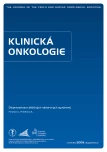Current Methods in Diagnostics and Monitoring of Patients with Hereditary Polyposis Syndromes. Investigation of the Small Intestine
Authors:
K. Klímová 1; J. Trna 1; J. Tomášek 2
Authors‘ workplace:
Interní hepatogastroenterologická klinika FN Brno a LF Masarykovy univerzity, Brno 2Klinika komplexní onkologické péče MOÚ a LF Masarykovy univerzity, Brno
1
Published in:
Klin Onkol 2009; 22(Supplementum): 60-64
Overview
Backgrounds:
Familial polypous syndromes include, in particular, familial adenomatous polyposis, Peutz-Jeghers syndrome and familial juvenile polyposis. The cumulative risk of developing cancer of the small intestine is higher and ranges between 5 to 13%. Close follow up is therefore very important in the prevention of both malignant and benign complications of the basic disease. Currently there are many methods that can be offered to follow up patients with hereditary polyposis syndromes. The anatomy of the gastrointestinal tract can be investigated by endoscopy or double-contrast radiological techniques. The part of the small intestine between the duodenum and terminal ileum is difficult to reach by standard endoscopy and can only be judged by radiological enteroclysis, which has the disadvantage of exposing the patient to X rays, moreover, it is impossible to examine the pathological findings histologically. However, new and more accurate enteroscopical (single and double-balloon, including intraoperative) methods and capsule enteroscopy have recently started to be used in routine clinical practice: Capsule endoscopy is an endoscopical method that enables us to examine the whole small intestine. This technology consists of swallowing a capsule the size of a bean that is later moved by motility of the gastrointestinal tract distally. A doctor then evaluates the record. Intraoperative enteroscopy is ever more often substituted by balloon enteroscopy. However, it remains a possibility when traditional double-balloon enteroscopy does not solve the patient’s problems definitely; this occurs mainly in patients with intestinal adhesions or multiple lesions of the small intestine, endoscopically insolvable. Balloon enteroscopy is a modern endoscopic method that is used to examine the whole small intestine that also enables therapeutic efforts to be carried out when routine endoscopy is not successful. In some indications it has substituted intraoperative enteroscopy.
Conclusion:
These three methods are complementary, are connected in the examination algorithm and cannot be replaced by each other. Some authors consider them the golden standard in investigating the small intestine.
Key words:
familial polypous syndromes – capsule endoscopy – intraoperative endoscopy – balloon enteroscopy
Sources
1. Minardi AJ Jr, Zibari GB, Aultman DF et al. Small bowel tumours. J AM Coll Surg 1998; 186: 664–668.
2. Boudiaf M, Jaff A, Soyer P et al. Small bowel diseases: prospective evaluation of multi detector row helical CT enteroclysis in 107 consecutive patients. Radiology 2004; 233: 338–344.
3. Schulman K, Schwiege K. Capsule endoscopy for small bowel surveillance in hereditary intestinal polyposis and non polyposis syndromes. Gastrointestinal Endosc. Clinic Nam 2004; 14: 149–158.
4. Appleyard M, Fireman Z, Glukhovsky A et al. A randomized trial comparing wireless capsule endoscopy with push enteroscopy for the detection of small bowel lesions. Gastroenterology 2000; 119: 1431–1438.
5. Tachecí I a kol. Kapslová enteroskopie. Hradec Králové: Nucleus 2008.
6. Beneš Z. Hep A. Význam gastroskopie pro dnešní praxi. Med Pro Praxi 2006; 4: 197–198.
7. Lukáš M. Idiopatické střevní záněty a kolorektální karcinom. Nové souvislosti a další perspektivy. Čes a Slov Gastroent a Hepat 2006; 60(3): 113–118.
8. Tachecí I, Drastich P, Suchánek Š et al. Kapslová endoskopie – standard endoskopického vyšetření tenkého střeva. Doporučený postup České gastroenterologické společnosti ČLS JEP. Čes a slov Gastroent a Hepat 2007; 61(5): 269–275.
9. Kopáčová M. Dvojbalónová enteroskopie, jeji možnosti a alternativy. Čas Lék Čes 2009; 148(2): 91–96.
10. Bureš J, Rejchrt S, Široký M et al. Enteroskopie: diagnostické a terapeutické možnosti endoskopického vyšetření tenkého střeva. Interní medicína pro praxi 2000; 2: 34–36.
11. Yamamoto H, Kita H, Sunada K et al. Endoscopic diagnosis and treatment of small intestinal diseases using the double-balloon enteroscopy. Gastrointestinal Endoscop 2004; 59: 100.
12. Frič P, Zavoral M. Dispenzární programy vysokorizikových skupin kolorektálního karcinomu. Čes a Slov Gastroent a Hepat 2006; 60(5): 199–200.
13. Rex DK, Cutler CS, Lemmel GT et al. Colonoscopic miss rates of adenomas determined by back-to-back colonoscopies. Gastroenterology 1997; 112: 24–28.
14. Spigelman AD, Williams CB, Talbot IC et al. Upper gastrointestinal cancer in patients with familial adenomatous polyposis. Lancet 1989; 2: 783–785.
Labels
Paediatric clinical oncology Surgery Clinical oncologyArticle was published in
Clinical Oncology

2009 Issue Supplementum
Most read in this issue
- Hereditary Pancreatitis
- Gorlin Syndrome
- Multiple Endocrine Neoplasia Type 2 Syndrome
- Multiple Endocrine Neoplasia Type 1 Syndrome
